Ganesh Chaturthi, the fourth day in the bright fortnight of the lunar month called Bhadrapad (September) is Ganesha's birthday. People in Bombay are famous for arranging every year a very very big party for the beloved God with an elephant face. Yet all over India sincere devotees refresh their spiritual resolves and contemplate on the inner meaning of such a lovely Lord with an elephant face, who is balancing his physical weight on a little rat.
There are many ways to invoke Ganesha through various pujas (ways of worship) and spiritual disciplines. Devotees of the Lord will of course first of all take an early morning bath, wear fresh clothes and clean their place of worship at home or go to a Ganesha temple to offer red flowers, fragrent scent, delicious sweets as well as mantras and prayers.
Ganesha is easily pleased and simply invoked: To worship him it is enough to put a red sandelwood dot on a stone or on a piece of clay and wrap a red cotton thread around.
On Ganesha's birthday devotees may take a fresh resolve to intensify their practical spiritual sadhana. Some might promise that they will fast from now onward on each "Ganesha Chaturthi" (fourth "tithee", means "lunar day", in the descending, or dark moon cycle). Eating only once a day in the evening some sattvic items after listening to the related teaching story of each Chaturthi fast. Others might wish to practice a particular number of "japa", repetition of a mantra or the Name of the Lord, in spoken or written form. Others may keep mauna (outer and/or inner silence), and others may construct and paint the Yantra of Sri Ganesha, prepare delicious sweets, or start to paint any form of him, sing bhajans, or meditate.
Whenever Ganesha's birthday, also known as Mahasiddhi Vinayaki Chaturthi, is falling on a Tuesday or Saturday it is inhancing its importance and is then known as Varad or Shiva Chaturthi.
In North India Ganesha is very happy when people offer him "Baison Laddus" (sweets made from roasted chickpea flour, ghee (clarified butter), sugar and green cardamom) and "Chanamrit" (a delicious Joghurt drink made from fresh plain Joghurt, water, sugar, honey, a drop of ghee, little milk or/and a drop of ganga jal (water from the holy river Ganges).
About Lord Ganesha
Ganapati, the God of Wisdom, with his big cosmic belly and a beautiful elephant face brings happiness to all existing beings. "He is the one who is immortal, all-merciful, and all-forgiving, and he bestows on his devotees a well-disposed mind", states an ancient scripture known as Ganesha Pancharatnam. The son of Mother Parvati and Lord Shiva is the most popular God in India. Practically everyone who believes in Him - not only as a symbol to explain Hindu philosophy, but as "real being" - invokes him first, knowing that HIS blessings grant smooth sailing. Ganesha is that all-pervading "spark" of Cosmic Consciousness that connects us with our "inherent wisdom" and allows us to start and complete a sacred rite or an auspicious work, and to find solutions to the problems we all face from time to time.
The name "Ganesha" is actually a kind of title for the ONE who is the Lord ( isha) of all existing beings ( ganas ). That means that anyone (all existing beings) can pray to him and ask for his support, blessings and grace. Most probably Ganesha's looks are the biggest hurdle for people with a rational mind, trained in overestimating the outside appearance of people and "things". No doubt, for a rational mind it is a real challenge to think of "God" having an elephant head. Ganesha's message is to go beyond the visible world, to approach our higher wisdom center and get access to the right hemisphere of our brain. Those who see beyond the outer appearance will see the real Ganesha, which is not the body but the energy which is constructive and divine. Ganesha is the one who demands pure faith, for it is faith that can work miracles and open the doors to all divine experiences.
The wise one's have deeply thought about the meaning of Ganesha's outer form and attributes and it's helpful to listen to some of their interpretations:
Lord Ganesha's elephant head symbolises the immense inner wisdom, that realized beings, or persons of perfection, have. Inner wisdom comes from deep inside, it is born through manana, independent thinking and reflection. The wise one's say, m anana only comes after one has gained spiritual inside through shravanam. Shravana means "listening", whole hearted careful listening to what a teacher has to say.
Ganesha's large ears remind us on the immense importance of the "Indian oral teaching tradition", where words of wisdom are passed on from mouth to ear from generation to generation. Mostly people are afraid to listen, because they fear they will have to change their oppinion if they understand. But listening to noble thoughts and ideas and keeping our mind open for different opinions will make us wise. Careful and loving listening to what others say will save us from many problems and conflicts.
Ganesha's trunk stands for his power of discrimination. He can discriminate between the pairs of opposites, the rights and wrongs, the likes and dislikes, the everlasting and the neverlasting.
Ganesha's large belly is telling us that the entire universe has its existence in him. The universe originates from him, and he sustains it and protects it in his womb like a mother.
The rat as the Lord's vehicle of transport is a symbol for the challenge that a spiritual person faces when trying to communicate the knowledge of the infinite Self through the finite (and therefore unfit) equipments of body, mind and intellect. Atman (soul) cannot be touched with the body, felt through emotion or understood with the intellect. One can only become It through spiritual practice.
Ganesha four arms represent the four padarthas, aarth, dharma, kama, moksha, which are the four necessities for the preservation of human life. Aarth encompases means, money, wealth. Dharma is the inherent law of nature, the essence of nature. Understanding dharma gives us an understanding of oneness with all that exists. Kama is communion. Moksha is liberation from the wheel of reincarnation.
Ganesha is dancing and gracefully balancing his spacy belly inside a lotus - the symbol of purity. In one hand he is holding a sweet laddu (representing the sweet or sattvic rewards of selfless devotion to God). In the second hand he holds his tusk, which he - according to one legend - broke to write down the famous epic "The Mahabharata". In his upper right hand he carries an axe with which he is cutting the illusiory identifications of his devotees with their physical body and the material world. In the upper left hand he holds the snake, which points to his relationship with his father, the compassionate Lord Shiva, who concored the snakes of desires.
Aum Gang Ganapataye Namah (Salutations to the Lord of all beings) is the Mantra of Lord Ganesha. It invokes inner wisdom and thus helps us to overcome obstacles.
Aum is the primordial sound, it represents Lord Ganesha and its utterance opens our innermost being to the vibration of higher reality. No mantra can be recited without first uttering AUM. Gang is the seed sound of Ganesha. Gana means category, pati means lord; so Ganapataye is the Lord of all creation. Namah means bowing the head with devotion.
Stories as to how Ganesha got his elephant head are many and differ - some say - "according to the yuga (time)" in which Ganesha appeared in this world for a specific reason, i.e. to save Mother Earth from different demons. Those stories are preserved in different "Puranas" (ancient scriptures).
One story makes Lord Shiva responsible that Ganesha's lost his human head. This beautiful story can be read in our children book edition "How Ganesh Got His Elephant Head", ISBN 1-59143-021-6, ISBN 1-59477-030-1 (Indian Edition), Inner Traditions.
Another story narrates that Ganesha was loosing his human head through the sight of the planet Saturn (Shani Deva). This story is told in the Ganesha Chalisa (fourty prayer rhyms), which devotees commonly recite during the worship of Lord Ganesha.
The story being remembered on HIS birthday is related to the moon. It tells us how the moon was bursting out in loud laughter when he saw Ganesha with an overfull stomach returning home from a party, balancing his belly on his tiny-mini mouse. Moon's laughter made Ganesha very angry. (Ayurvedic doctors say that during the month of Bhadrapad "pitta", the fire element in the body, increases and needs to be purified by keeping a proper diet.) In a fit of anger Ganesha cursed the moon. And that's the reason why one should strictly avoid looking at the moon during the Ganesh Chaturthi in the lunar month called Bhadrapad (September), i.e. the birthday of Ganesha. A story from the life of Lord Krishna gives an example for the problems that could arise if one glances at the moon on Ganesha's birthday (see details in SRIMAD BHAGAVATAM, 10 th chapter, paragraph 56-57). Even Lord Krishna, the Supreme Consciousness, suffered once being falsely accused for the theft of the precious Syamantak Gem.
But as ever in India - there is always a solution to any problem. To avoid false accuses or minimize their effect one has several choices. Those who like to take precautions can train themselves to become more conscious by looking at the moon in the night of every second lunar day in the bright moon cycle. Others can choose to look at the moon on the 3 rd and 5 th lunar day and also will not face problems, even if it happens that the look at the moon on Ganesha's birthday.
However, Lord Ganesha is the starting point for all spiritual rites. Visualisation of Ganesha brings success in all undertakings and helps in stopping the internal dialog.
According to the secret hymn known as Atharva Veda Ganesha is Brahma (the creator), Vishnu (the sustainer), and Rudra (the destroyer). HE is earth, water, fire, air, akash (space). HE is the eternal witness. He is Brahman, the eternal spirit inherent in everything. HE is the personification of the primordial sound AUM, and so HE is the Beginning and the End of everything.
| |
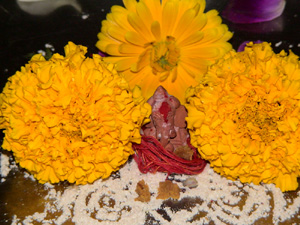 |
| |
|
| |
|
| |
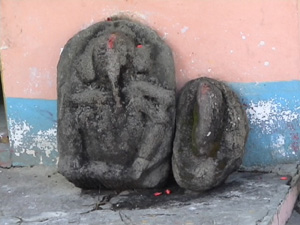 |
| |
Ganesha comes in the most simple forms |
| |
|
| |
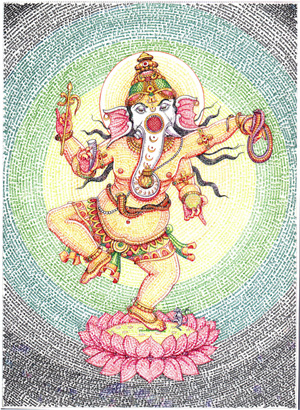 |
| |
|
| |
|
| |
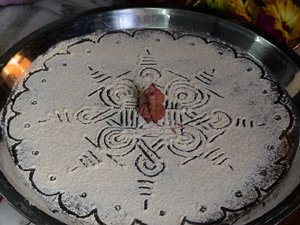 |
| |
Ganesha yantra in flour |
| |
|
| |
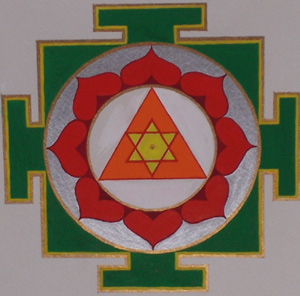 |
| |
Painted Ganesha yantra |
| |
|
| |
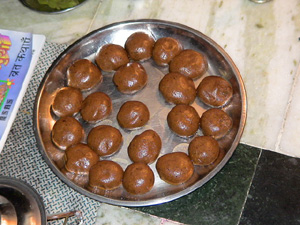 |
| |
Baison laddus |
| |
|
| |
 |
| |
Chanamrit (yoghurt prasad) |
| |
|
| |
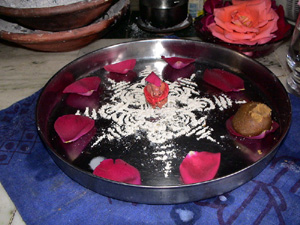 |
| |
Flour yantra puja plate |
|
 Text written by Heidi Rauhut.
Text written by Heidi Rauhut. 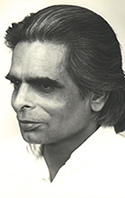 Sanatan Society is an international networking association of students of the late Harish Johari, joining efforts to promote his teachings of yoga philosophy, tantra, worship, art and love. Sanatan Society stands
for the original, universal and eternal truth, path or law of yoga.
Though it is Hindu in origin, Sanatan Society is not limited to any religion,
race, time or country, nor in fact to any particular organisation. More about Sanatan Society...
Sanatan Society is an international networking association of students of the late Harish Johari, joining efforts to promote his teachings of yoga philosophy, tantra, worship, art and love. Sanatan Society stands
for the original, universal and eternal truth, path or law of yoga.
Though it is Hindu in origin, Sanatan Society is not limited to any religion,
race, time or country, nor in fact to any particular organisation. More about Sanatan Society...